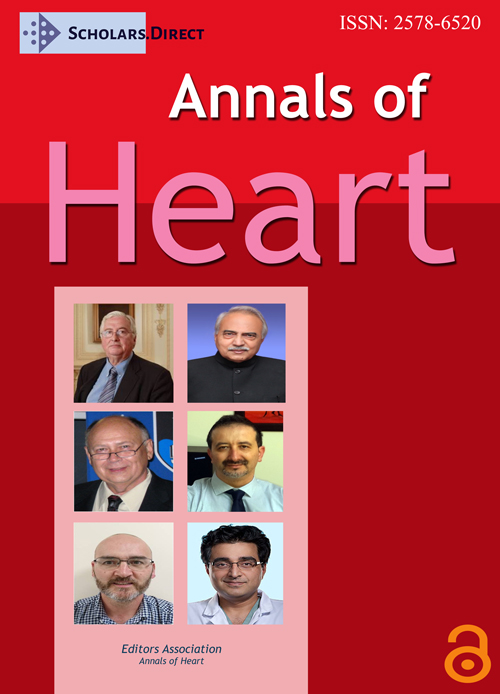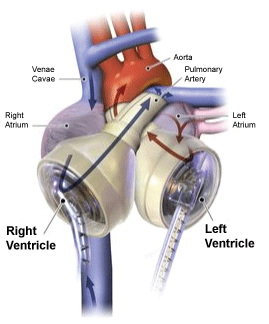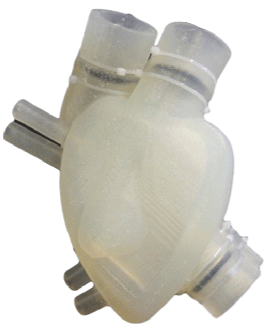Editorial on Advances in Artificial Heart
Introduction
Biological heart is like an engine inside the body that keeps everything running. In a day, heart pumps approximately two thousand gallons of blood. Like any other engine if heart is not taken care; it can break down and pump less efficiently and this condition is called heart failure.
There is a scarcity of organs for heart transplants and demand for organs always greatly exceeds the supply. Hence an artificial heart is required; it is a mechanical device that permanently replaces biological heart where heart transplantation is impossible. Below are few discussed from advanced technologies on artificial heart that will benefit human kind to advance in the long run [1,2] (Figure 1).
Total Artificial Soft Heart
A novel artificial soft heart was developed using three-dimension printing technology that entirely soft pumps with complex chamber geometrics. With this unique method completely soft pneumatically can be driven from silicone elastomers and has been evaluated its performance on a hybrid mock circulation. In this technology soft total artificial heart (sTAH), consists of only two ventricles which was produced using three-dimension printing and lost wax casting technique. The diastolic properties of the sTAH were well-defined and the performance of the sTAH was evaluated on a hybrid circulation under various physiological conditions.
This technology was invented by Nicholas H Cohrs, Anastasios Petrou, et al. [3] from ETH Zurich, Switzerland. It weighs around 390 g and has a volume of 679 cm^3 and is operated over pressurized air (Figure 2).
Lesser Infections in Mechanical Heart Valves
A lot of people undergo aortic valve replacement every year in Sweden and about seventy five percent of whom receive biological valve, the remainder are mechanical ones. The main problem is that it carries a high fatality risk is prosthetic valve endocarditis, which happens when the new valve is infected by bacteria. Until now, there have been no facts on whether the infection frequency differs between the two valve types. It has also been unidentified how common infections in an artificial heart valve are. The study involved around twenty-six thousand and five hundred patients who received prosthetic heart valve in the year between 1995 and 2012 out of whom nine hundred and forty of them developed prosthetic valve endocarditis.
A study from Karolinska Institute shows that infections in surgically implanted heart valves are more common in patients who have given biological prosthetic valve compared to mechanical one [4].
World Smallest Pacemaker
When there is lower heart rate, heart is unable to pump enough oxygen rich blood to the body during normal activity, exercise causing dizziness, fatigue and shortness of breath or fainting.
Food and Drug Administration (FDA) has approved Micra Transcatheter Pacing System (TPS) a novel type of heart device that provides patients with most advanced pacing equipment at one tenth size of a traditional pacemaker and it is the only pacemaker approved for use in United States. The device is the size of a large vitamin and it does not require cardiac wires (leads) or a surgical "pocket" under the skin to deliver pacing therapy unlike traditional pacemakers.
This system was invented at Houston Methodist Hospital that is one of the first hospital in Texas to offer world's smallest pacemaker for patients with bradycardia, a condition that is considered by a slow heart rate, usually fewer than sixty beats per minute [5].
Improved Quality of Life Using Artificial Heart
Nurullah, a former soccer player had heart problems first began in 2002 when he suffered a heart attack and received several stents. After five years he was diagnosed with congestive heart failure. His condition continued to deteriorate as time went on. In May 2012, he was diagnosed with heart failure affecting two sides of his heart (biventricular failure). In addition, three of his four heart valves were leaking.
In Aug 12, 2012, his heart was replaced with Total Artificial Heart (TAH) and as of April 19, 2017 who surpassed 4.6 years of life with Total Artificial Heart; has become longest supported Total Artificial Heart patient in the world [6].
Reliability Statistics of Artificial Heart
At this time, because of the small implantation numbers of nearly all of artificial heart designs, it is almost impossible to establish credible and accurate data on the reliability of the designs.
The one exception is the Syn Cardia Total Artificial Heart and its predecessors have been implanted around one thousand three hundred and fifty-two times over more than thirty years. In those three decades of use:
• The valves in the Total Artificial Heart never failed (after the first implant).
• The diaphragm, which is responsible for pumping blood in and out of each ventricle, has a reliability rate exceeding 99.5% for more than one thousand three hundred implants representing more than two thousand seven hundred diaphragms [7].
In conclusion, Annals of Heart Journal will be dedicated to continue to concentrate with the international research community to accomplish strongest possible scientific picture on coming up extent of prospect for outstanding quality for human kind.
References
- https://science.howstuffworks.com/innovation/everyday-innovations/artificial-heart.htm.
- https://en.wikipedia.org/wiki/Artificial_heart.
- Cohrs NH, Petrou A, Loepfe M, et al. (2017) A Soft total artificial heart-first concept evaluation on a hybrid mock circulation. Artif Organs 41: 948-958.
- Natalie Glaser, Veronica Jackson, Martin J Holzmann, et al. (2017) Prosthetic Valve Endocarditis After Surgical Aortic Valve Replacement. Circulation 136: 329-331.
- www.sciencedaily.com/releases/2017/02/170202142015.htm.
- https://syncardia.com/news/turkish-man-becomes-worlds-longest-supported-syncardia-temporary-total-artificial-heart-patient/.
- https://globenewswire.com/news-release/2014/09/12/665723/10098415/en/7-Things-About-Artificial-Hearts-That-You-Should-Know.html.
- http://newsroom.ucla.edu/releases/ucla-patient-is-first-to-successfully-receive-a-heart-transplant-after-using-experimental-50cc-total-artificial-heart.
- https://www.sciencedaily.com/releases/2017/07/170713154855.htm.
Corresponding Author
Manu Mitra, Department of Electrical Engineering, University of Bridgeport 126 Park Avenue, Bridgeport, CT-06604, USA.
Copyright
© 2018 Mitra M. This is an open-access article distributed under the terms of the Creative Commons Attribution License, which permits unrestricted use, distribution, and reproduction in any medium, provided the original author and source are credited.






